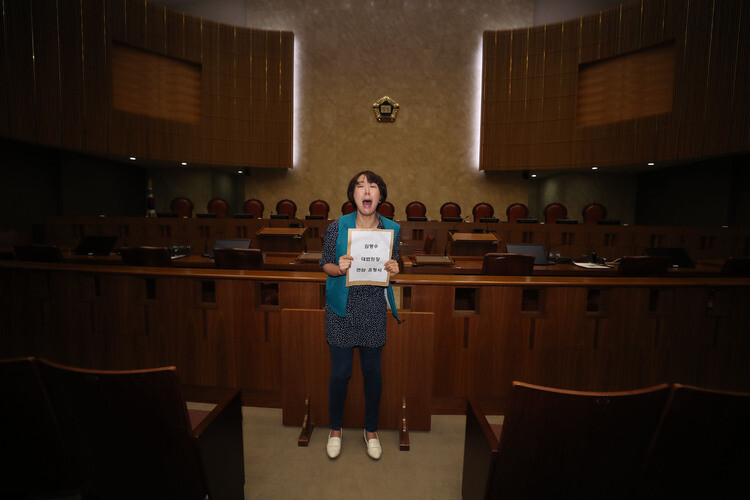hankyoreh
Links to other country sites 다른 나라 사이트 링크
[Editorial] Dismissal of KTX female train attendants possible result of political tradeoff

The front page of The Hankyoreh’s May 30 edition shows an image of a weeping Kim Seung-ha. After a two-year, three-month stint as a KTX train attendant, she has been living as a dismissed worker for over 12 years. A demonstration by Kim and other female train attendants the previous day to demand a meeting with Supreme Court Chief Justice Kim Myeong-soo sparked fears of an unprecedented “storming” into the main courtroom of the Supreme Court. But their anger and frustration were legitimate: the ruling that ruined their lives in an instant may indeed have been the result of a political tradeoff or negotiation.
The dismissal of female train attendants at KTX (South Korea’s high-speed rail service) is one of the best-known examples of the outsourcing of women and irregular workers. Female train attendants in their twenties had beaten the fierce competition for KTX-affiliated companies in 2004 (only 1 out of 14 applicants were hired) to get jobs at a full subsidiary of the Korea Railroad Corporation (Korail) on the understanding that they would be converted to regular workers and directly hired by Korail.
When they went on strike two years later, demanding the end of the irregular worker system, they were forced out of the company. In a lawsuit that 34 of the 180 workers who were ultimately dismissed filed against Korail, asking the court to confirm their employment status, both the district and high court ruled that Korail was their effective employer. But in 2015, the Supreme Court overturned these rulings: “It cannot be concluded that a direct working relationship was in place, nor does this correspond to a temp-work relationship.”
Because of this ruling, each of the dismissed train attendants was saddled with nearly 100 million won (US$93,100) in debt, which included four years of wages they had received since the first ruling, plus interest. One of the dismissed train attendants committed suicide, leaving behind a three-year-old child.
According to a document drafted for a meeting between former Supreme Court Justice Yang Sung-tae and former president Park Geun-hye that turned up in a recent special investigation of alleged abuse of authority in the judiciary, the National Court Administration described the Supreme Court’s ruling as “an example of the judiciary cooperating as much as possible within the bounds of its authority and discretion in order to enable smooth governance by then president Park Geun-gye and her Blue House.”
Even at the time, the Supreme Court’s ruling was heavily criticized for the bizarre fact that it did not even mention the points of contention in the first two trials, and now the court’s impartiality itself is open to question. The attitude of the National Court Administration, which selected this ruling as one of its proudest examples of cooperation with the Blue House, is far removed from the judiciary’s presumed role as the final bastion of human rights and justice.
On May 30, Kim Hwan-su, the chief justice’s chief of staff, met with the protesters. The way to provide them with some measure of consolation is to achieve justice by carrying out a thorough investigation and punishing the guilty parties. This year, Korail has already agreed to reinstate all the union members who had been fired, and we hope that it will also be more proactive about dealing with the issue of the train attendants.
Please direct comments or questions to [english@hani.co.kr]

Editorial・opinion
![[Guest essay] The real reason Korea’s new right wants to dub Rhee a founding father [Guest essay] The real reason Korea’s new right wants to dub Rhee a founding father](https://flexible.img.hani.co.kr/flexible/normal/500/300/imgdb/original/2024/0423/8317138574257878.jpg) [Guest essay] The real reason Korea’s new right wants to dub Rhee a founding father
[Guest essay] The real reason Korea’s new right wants to dub Rhee a founding father![[Column] ‘Choson’: Is it time we start referring to N. Korea in its own terms? [Column] ‘Choson’: Is it time we start referring to N. Korea in its own terms?](https://flexible.img.hani.co.kr/flexible/normal/500/300/imgdb/original/2024/0423/3617138579390322.jpg) [Column] ‘Choson’: Is it time we start referring to N. Korea in its own terms?
[Column] ‘Choson’: Is it time we start referring to N. Korea in its own terms?- [Editorial] Japan’s rewriting of history with Korea has gone too far
- [Column] The president’s questionable capacity for dialogue
- [Column] Are chaebol firms just pizza pies for families to divvy up as they please?
- [Column] Has Korea, too, crossed the Rubicon on China?
- [Correspondent’s column] In Japan’s alliance with US, echoes of its past alliances with UK
- [Editorial] Does Yoon think the Korean public is wrong?
- [Editorial] As it bolsters its alliance with US, Japan must be accountable for past
- [Guest essay] Amending the Constitution is Yoon’s key to leaving office in public’s good graces
Most viewed articles
- 1[Editorial] Japan’s rewriting of history with Korea has gone too far
- 2Samsung barricades office as unionized workers strike for better conditions
- 3[Column] ‘Choson’: Is it time we start referring to N. Korea in its own terms?
- 4Why Korea shouldn’t welcome Japan’s newly beefed up defense cooperation with US
- 5[Column] The clock is ticking for Korea’s first lady
- 6[Guest essay] The real reason Korea’s new right wants to dub Rhee a founding father
- 7Korean government’s compromise plan for medical reform swiftly rejected by doctors
- 8[Reporter’s notebook] Did playing favorites with US, Japan fail to earn Yoon a G7 summit invite?
- 9[Column] The president’s questionable capacity for dialogue
- 10Senior doctors cut hours, prepare to resign as government refuses to scrap medical reform plan